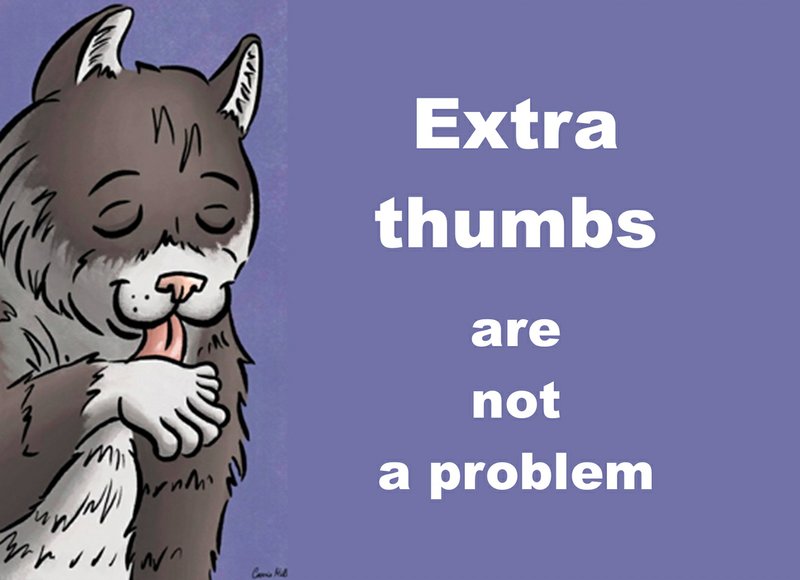Q: I've had cats before, but none ever looked like the cat I adopted this week from the shelter. Both of her front paws have the normal four toes — plus three thumbs instead of one. I've never seen a cat with so many thumbs. What is this called? Should the extra thumbs be surgically removed?
A: Your new cat is polydactyl, which in Greek means multiple (poly-) digits (-dactyl). This common, inherited condition poses no problems, provided that you trim the claws on the thumbs to prevent them from growing into the pads.
Most cats have five toes on their front paws and four on the rear paws, which lack the "big toe." Toes are numbered from the thumb to the baby finger, so the thumb is digit 1, the pointer finger is digit 2, and the outermost is digit 5.
Extra toes are numbered with decimals or letters. Thus, a single additional thumb may be referred to as digit 1.5, or several thumbs may be called 1a, 1b, 1c and so forth.
Polydactylism affects the cat's front paws more often than the hind paws. In some cats, the extra thumbs on the front feet are opposable, making it easier for the cat to manipulate small objects.
Long ago, sailors called their polydactyl felines "ship's cats" and considered them good luck because they were excellent mousers and could even climb the rigging in pursuit of their prey.
When Ernest Hemingway lived on Key West, half of his approximately 50 cats were polydactyl; their multi-toed descendants still live there. Thus, cats with extra toes are sometimes called "Hemingway cats."
Enjoy your special new kitty. My experience is that polydactyl cats are very sweet indeed.
Q: Marty, my 16-year-old dog, is blind and arthritic. He still wags his tail, but he's not as social as he used to be, and even with his arthritis medication, it's harder for him to get around.
I want him with me as long as he is happy and comfortable, but I don't want him to suffer, so I'll have his veterinarian euthanize him when his quality of life is poor. How will I know the right time?
A: My heart is with you as you prepare to make this painful decision. Fortunately, Dr. Alice Villalobos, a veterinary oncologist who focuses on palliative and hospice care, developed a detailed quality of life scale that I have found valuable with my own pets, and I'm sure it will help you, too.
It's called the HHHHHMM scale, and it takes into account these seven concerns:
◼️ Hurt: Adequate pain control and effortless breathing are at the top of this quality of life scale. How well is Marty's arthritis pain being managed?
◼️ Hunger: Is he eating well? Does he require hand-feeding?
◼️ Hydration: Is Marty dehydrated? If he requires regular fluid administration, does he tolerate the procedure well?
◼️ Hygiene: Does he let you brush him and clean him up after he eliminates? If Marty were a cat, we'd ask how well he grooms himself.
◼️ Happiness: You said Marty still wags his tail but is less social. How responsive is he to life around him? Does he seem joyful, depressed, anxious or afraid? Is his bed close to family activities or isolated?
◼️ Mobility: Can Marty get up and move around on his own? Does he enjoy going for walks?
◼️ More good days than bad: When the bad days outnumber the good, it's time to recognize that Marty may be suffering.
Assign each of the seven concerns a number from 1 (for unacceptable) to 10 (excellent). When you add up the numbers, a score over 35 represents an acceptable quality of life.
I hope the remaining time you and Marty have together is full of tender joy and gentle kisses.
Dr. Lee Pickett, VMD, practices companion animal medicine in North Carolina. Contact her at
askthevet.pet
Style on 04/13/2020
